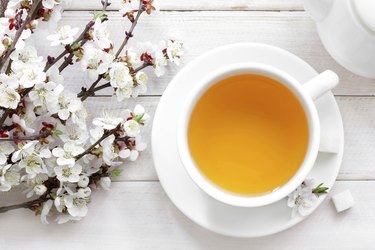
Tea drinkers rejoice: Tazo tea brings you a blend of unusual ingredients, many of which have healthy long-term effects. Tazo tea health benefits, particularly in Tazo passion tea contain ingredients that contain essential vitamins and minerals.
Tazo Passion Tea Ingredients
Video of the Day
Tazo passion tea is a commercially produced herbal tea blend that consists of hibiscus flowers, natural tropical flavors, citric acid, licorice root, orange peel, rose hips, cinnamon and fruit juice extract, according to the official TAZO website. Tazo prides itself on producing unexpected flavor blends by mixing unexpected ingredients.
Video of the Day
You can find Tazo tea in Starbucks or on the shelves of some of your favorite grocery stores. If you choose to make the tea yourself, the Tazo website provides instructions. Step one requires bringing water to a boil. Next, pour 8 ounces of water over the filter bag in your cup. Finally, wait five minutes for the tea to steep.
The Tazo passion tea reviews on the TAZO website are mostly positive, with a rating of 4.8 out of 5 stars. Most reviewers are longtime Tazo passion tea drinkers who greatly enjoy the flavor. In the reviews for Tazo passion iced tea, many individuals recommend combining the passion tea with lemonade for a refreshing summer drink.
Read more: What are the Benefits of Eating Tea Leaves?
Passion Tea Benefits
There are a number of passion tea benefits, as each ingredient contains health-advantages:
Orange peel: Orange peels are full of vitamins and minerals, some of which contain antioxidant properties. According to USDA, 100 grams of orange peels contain 136 milligrams of vitamin C, 212 milligrams of potassium, 420 international units of vitamin A and 161 milligrams of calcium. Some studies and reviews like this August 2014 review in BioMed Research International, point to the anticarcinogenic, or cancer-fighting, properties in citrus fruits.
A September 2018 review in Frontiers in Nutrition explains that polyphenols, found in orange peels, have anti-inflammatory effects and can help prevent and manage certain diseases, such as obesity and type 2 diabetes. The review also underscores that flavonoid-rich foods, such as oranges, can be good for cardiovascular health.
Hibiscus: Hibiscus has been found to help treat hypertension. A March 2013 review in Fitoterapia, found a link between the consumption of hibiscus extract and lowering blood pressure in adults with pre to moderate essential hypertension and type 2 diabetes.
Read more: The Disadvantages of Tea
And More Passion Tea Benefits
Rose hip: According to MedlinePlus, rose hip, the part of the rose flower below the petals, has many medicinal applications, the most effective being its use in the treatment of osteoarthritis. Research from The Royal Australian College of General Practitioners confirms that taking rose hip powder decreases pain and stiffness in those with osteoarthritis. Fresh rose hip also contains a large amount of vitamin C, though when dried, the amount of vitamin C declines.
Lemongrass: A popular herb in Asian cooking, lemongrass contains vitamins B1, B2, B5, B6 and folate, which helps the production of red blood cells, says Better Health Channel. It also contains manganese, which regulates brain and nerve function, iron, which helps produce red blood cells, potassium, which manages blood pressure, magnesium and calcium that keep bones strong and regulates muscle, heart and nerve function.
Licorice Root: According to The University of Rochester, licorice root is purported to have many medicinal purposes, though many of those claims are unsubstantiated. However, there has been research pointing to licorice as a possible treatment for hepatitis C when administered as a shot, though, still, more evidence is needed. There's also some evidence that licorice can help alleviate redness, swelling or itching explains NIH.
Cinnamon: An April 2014 review in Evidence-Based Complementary and Alternative Medicine, describes some cinnamon benefits. The spice is said to contain antioxidant, antimicrobial properties, while also helping stave off bad breath, produce coagulant effects and increase blood circulation.
- Tazo: "Passion"
- Frontiers in Nutrition: "The Role of Polyphenols in Human Health and Food Systems A Mini Review"
- BioMed Research International: "Anticancer Activities of Citrus Peel Polymethoxyflavones Related to Angiogenesis and Others"
- USDA: "Organge Peel, Raw"
- Fitoterapia: "Hibiscus Sabdariffa L. in the Treatment of Hypertension and hyperlipidemia: A Comprehensive Review of Animal and Human Studies"
- MedlinePlus: "Rose Hip"
- Better Health Channel: "Lemongrass"
- University of Rochester: "Licorice Root"
- NIH: "Licorice Root"
- Evidence-Based Complementary and Alternative Medicine: "Cinnamon: A Multifaceted Medicinal Plant"
- The Royal Australian College of General Practitioners: "An evidence basedHerbal Medicine for Inflammation and Arthritis"